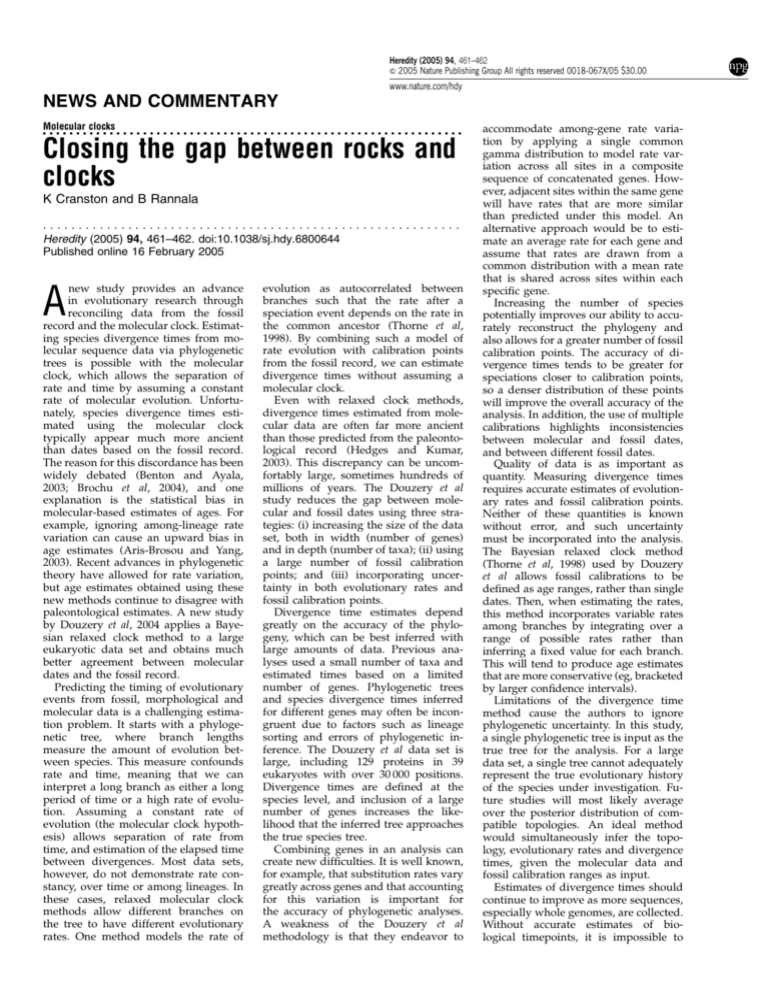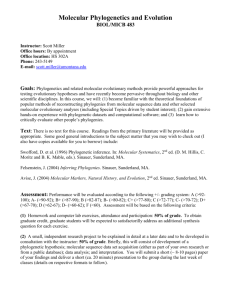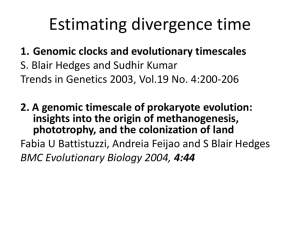
Heredity (2005) 94, 461–462
& 2005 Nature Publishing Group All rights reserved 0018-067X/05 $30.00
www.nature.com/hdy
NEWS AND COMMENTARY
Molecular clocks
...............................................................
Closing the gap between rocks and
clocks
K Cranston and B Rannala
...........................................................
Heredity (2005) 94, 461–462. doi:10.1038/sj.hdy.6800644
Published online 16 February 2005
new study provides an advance
in evolutionary research through
reconciling data from the fossil
record and the molecular clock. Estimating species divergence times from molecular sequence data via phylogenetic
trees is possible with the molecular
clock, which allows the separation of
rate and time by assuming a constant
rate of molecular evolution. Unfortunately, species divergence times estimated using the molecular clock
typically appear much more ancient
than dates based on the fossil record.
The reason for this discordance has been
widely debated (Benton and Ayala,
2003; Brochu et al, 2004), and one
explanation is the statistical bias in
molecular-based estimates of ages. For
example, ignoring among-lineage rate
variation can cause an upward bias in
age estimates (Aris-Brosou and Yang,
2003). Recent advances in phylogenetic
theory have allowed for rate variation,
but age estimates obtained using these
new methods continue to disagree with
paleontological estimates. A new study
by Douzery et al, 2004 applies a Bayesian relaxed clock method to a large
eukaryotic data set and obtains much
better agreement between molecular
dates and the fossil record.
Predicting the timing of evolutionary
events from fossil, morphological and
molecular data is a challenging estimation problem. It starts with a phylogenetic tree, where branch lengths
measure the amount of evolution between species. This measure confounds
rate and time, meaning that we can
interpret a long branch as either a long
period of time or a high rate of evolution. Assuming a constant rate of
evolution (the molecular clock hypothesis) allows separation of rate from
time, and estimation of the elapsed time
between divergences. Most data sets,
however, do not demonstrate rate constancy, over time or among lineages. In
these cases, relaxed molecular clock
methods allow different branches on
the tree to have different evolutionary
rates. One method models the rate of
A
evolution as autocorrelated between
branches such that the rate after a
speciation event depends on the rate in
the common ancestor (Thorne et al,
1998). By combining such a model of
rate evolution with calibration points
from the fossil record, we can estimate
divergence times without assuming a
molecular clock.
Even with relaxed clock methods,
divergence times estimated from molecular data are often far more ancient
than those predicted from the paleontological record (Hedges and Kumar,
2003). This discrepancy can be uncomfortably large, sometimes hundreds of
millions of years. The Douzery et al
study reduces the gap between molecular and fossil dates using three strategies: (i) increasing the size of the data
set, both in width (number of genes)
and in depth (number of taxa); (ii) using
a large number of fossil calibration
points; and (iii) incorporating uncertainty in both evolutionary rates and
fossil calibration points.
Divergence time estimates depend
greatly on the accuracy of the phylogeny, which can be best inferred with
large amounts of data. Previous analyses used a small number of taxa and
estimated times based on a limited
number of genes. Phylogenetic trees
and species divergence times inferred
for different genes may often be incongruent due to factors such as lineage
sorting and errors of phylogenetic inference. The Douzery et al data set is
large, including 129 proteins in 39
eukaryotes with over 30 000 positions.
Divergence times are defined at the
species level, and inclusion of a large
number of genes increases the likelihood that the inferred tree approaches
the true species tree.
Combining genes in an analysis can
create new difficulties. It is well known,
for example, that substitution rates vary
greatly across genes and that accounting
for this variation is important for
the accuracy of phylogenetic analyses.
A weakness of the Douzery et al
methodology is that they endeavor to
accommodate among-gene rate variation by applying a single common
gamma distribution to model rate variation across all sites in a composite
sequence of concatenated genes. However, adjacent sites within the same gene
will have rates that are more similar
than predicted under this model. An
alternative approach would be to estimate an average rate for each gene and
assume that rates are drawn from a
common distribution with a mean rate
that is shared across sites within each
specific gene.
Increasing the number of species
potentially improves our ability to accurately reconstruct the phylogeny and
also allows for a greater number of fossil
calibration points. The accuracy of divergence times tends to be greater for
speciations closer to calibration points,
so a denser distribution of these points
will improve the overall accuracy of the
analysis. In addition, the use of multiple
calibrations highlights inconsistencies
between molecular and fossil dates,
and between different fossil dates.
Quality of data is as important as
quantity. Measuring divergence times
requires accurate estimates of evolutionary rates and fossil calibration points.
Neither of these quantities is known
without error, and such uncertainty
must be incorporated into the analysis.
The Bayesian relaxed clock method
(Thorne et al, 1998) used by Douzery
et al allows fossil calibrations to be
defined as age ranges, rather than single
dates. Then, when estimating the rates,
this method incorporates variable rates
among branches by integrating over a
range of possible rates rather than
inferring a fixed value for each branch.
This will tend to produce age estimates
that are more conservative (eg, bracketed
by larger confidence intervals).
Limitations of the divergence time
method cause the authors to ignore
phylogenetic uncertainty. In this study,
a single phylogenetic tree is input as the
true tree for the analysis. For a large
data set, a single tree cannot adequately
represent the true evolutionary history
of the species under investigation. Future studies will most likely average
over the posterior distribution of compatible topologies. An ideal method
would simultaneously infer the topology, evolutionary rates and divergence
times, given the molecular data and
fossil calibration ranges as input.
Estimates of divergence times should
continue to improve as more sequences,
especially whole genomes, are collected.
Without accurate estimates of biological timepoints, it is impossible to
News and Commentary
462
conduct evolutionary studies that
make inferences about the effects of
environmental change on biodiversity,
or study the differences in microevolutionary processes between species. The
Douzery et al study is an important
first step toward refining the accuracy
of divergence times based on composite
fossil and molecular data sets. The
study also provides an important
stimulus for theoretical evolutionary
biologists, highlighting the limitations
of existing models and suggesting
directions for future research. The
Heredity
divergence time estimation problem is
an interesting combination of fossil,
morphological and molecular data. To
proceed, paleontologists, morphologists
and molecular evolutionists must individually and collectively refine their
methods in the hope that they will
ultimately reach a consensus about the
timing of the origins of major species
groups.
K Cranston is at the Department of Medical
Genetics, 539 Medical Sciences Building, University of Alberta, Edmonton, Alberta, Canada T6G
2H7. B Rannala is at the Genome Center and
Section of Evolution and Ecology, University of
California Davis, One Shields Avenue, Davis, CA
95616, USA.
e-mail: bhrannala@ucdavis.edu
Aris-Brosou S, Yang Z (2003). Mol Biol Evol 20:
1947.
Benton MJ, Ayala FJ (2003). Science 300: 1698.
Brochu CA, Sumrall CD, Theodor JM (2004).
J Paleontol 78: 1.
Douzery EJ, Snell EA, Bapteste E, Delsuc F,
Philippe H (2004). Proc Natl Acad Sci USA
101: 15386.
Hedges SB, Kumar S (2003). Trends Genet 19: 200.
Thorne JL, Kishino H, Painter IS (1998). Mol Biol
Evol 15: 1647.









